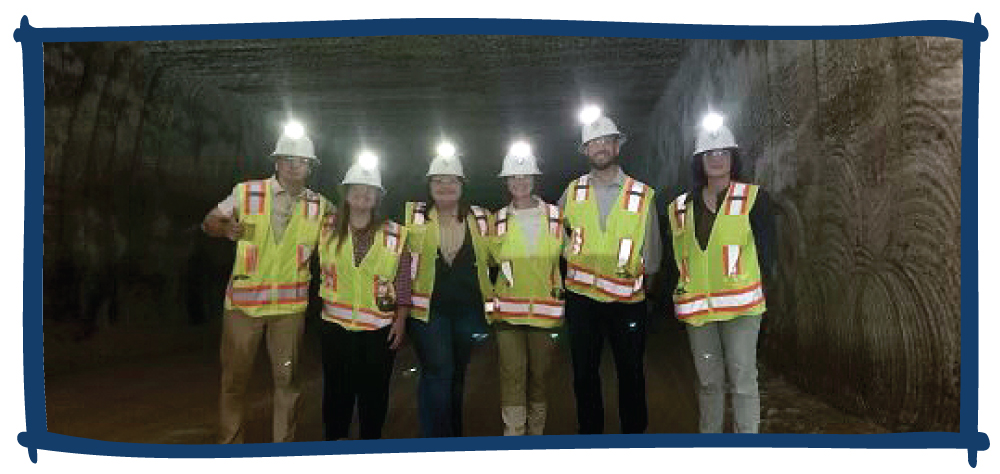Posted on May 23, 2024 by Frances Wetherbee and Grace Furman
ClearPath is constantly seeking out top private sector innovators, determining the barriers to their commercial success, and helping cultivate the environment that allows them to scale-up. In some instances, there are companies doing incredible work to support a more well known industry, but are less known in the halls of Congress.
What is known – nuclear energy accounts for about 20 percent of total United States electricity generated each year. It’s the largest zero-emissions power source in the U.S. and the industry directly provides an estimated 100,000 jobs. While recent incentives and demonstration programs have created a pathway for more power generation, attention is turning to where we source and how we manufacture the fuel; and, the ever-looming question of what we do with the spent fuel, or as many call it — nuclear waste.
We recently went out to see firsthand some of the exciting work being done to support the industry from fuel manufacturing to unique waste storage and disposal solutions. The Southwest region of the U.S. is home to facilities like Urenco USA (UUSA), Waste Control Specialists (WCS) and Waste Isolation Pilot Plant (WIPP), all of which play a vital role in shaping America’s nuclear landscape. ClearPath, along with Third Way and Columbia University’s Center on Global Energy Policy, recently visited these sites to explore the nuclear energy fuel cycle and ways policymakers can expand domestic production.
Urenco USA – Uranium Enrichment
UUSA, nestled in Eunice, New Mexico, is the nation’s sole commercial-scale uranium enrichment facility. Originally planned for Louisiana, it found a home in New Mexico after receiving overwhelming community support. With a combined construction and operating license issued by the Nuclear Regulatory Commission (NRC), uranium enrichment production began in June 2010.
UUSA supplies roughly one-third of U.S. uranium enrichment demand, a process that increases the concentration of energy-rich uranium in nuclear fuel. Another way to look at this: the amount of enriched uranium UUSA supplies could power every home in the USA for one day every two weeks. Enrichment companies like UUSA could take steps to increase domestic production following the recently passed legislation to secure the American fuel supply chain and ban Russian uranium.
Waste Control Specialists – Below Surface Disposal
Next door in Andrews, Texas, is Waste Control Specialists (WCS), a low-level radioactive waste (LLRW) treatment, storage and disposal facility. WCS supports the Department of Energy (DOE), private entities, nuclear power plants across the U.S., hospitals and universities. The waste accepted here includes materials from research facilities, hospitals extracting isotopes for diagnosis and treatment as well as military equipment. They have only used 2.6% capacity and can continue operation for years to come.

Front Row L to R: Hamna Khan (Columbia University), Mary Neumayr (Urenco), Amanda Sollazzo (ClearPath), Frances Wetherbee (ClearPath)
Back Row: Niko McMurray (ClearPath), Matt Bowen (Columbia University), Jack Ridilla (ClearPath), Rama Ponangi (Columbia University), Natalie Houghtalen (ClearPath),
Grace Furman (ClearPath), Rowen Price (Third Way)
Waste Isolation Pilot Plant (WIPP) – Deep Geologic Storage
DOE’s Waste Isolation Pilot Plant (WIPP) recently marked 25 years since accepting its first shipment of transuranic (TRU) waste in Carlsbad, NM. WIPP’s mission is to provide permanent, underground disposal of TRU and TRU-mixed wastes, wastes that also have hazardous chemical components.
WIPP is the country’s only active deep geological radioactive waste repository and a global example of responsible waste management, including the site operations and safety and security culture required for the site to operate efficiently.
The TRU waste is stored 2,150 feet underground in the 250 million-year-old Salado salt formation, which provides a stable environment for the long-term disposal of the radioactive waste. Every year, the salt walls close in four to six inches until the rooms are sealed. This natural process will in time permanently prevent the release of radioactive materials into the environment.

L to R: Jack Ridilla, Amanda Sollazzo, Grace Furman, Frances Wetherbee, Niko McMurray, Natalie Houghtalen
Local Impact
Nuclear facilities provide not only always-on, reliable, clean energy, but they also bring significant value to the surrounding areas. UUSA brings over 240 full-time jobs and 130 long-term contractor jobs, in addition to giving $625,000 annually to support local education, culture and environmental projects. WCS boosts its local economy with 175 full-time jobs and has provided $18.4 million in taxes to Andrews since opening in 2012. WIPP provides 1,700 jobs to New Mexico and, in 2023, invested $500,000 in local education and businesses. Deploying new nuclear energy creates hundreds of new jobs at the power plant and at supporting facilities.
Supporting energy infrastructure in the U.S. is vital to the health and success of the growing nuclear energy industry. From uranium enrichment to power production and waste disposal, nuclear facilities are an important and beneficial piece of America’s clean energy future. ClearPath will continue to be on the front lines helping tell the stories of American innovators who are solving the big energy challenges.
